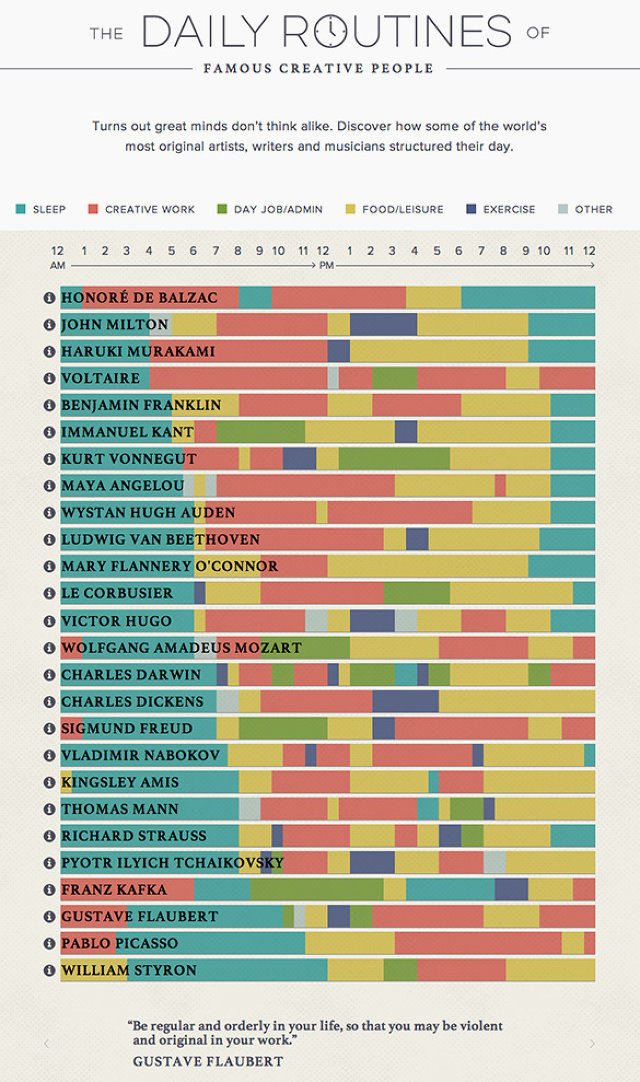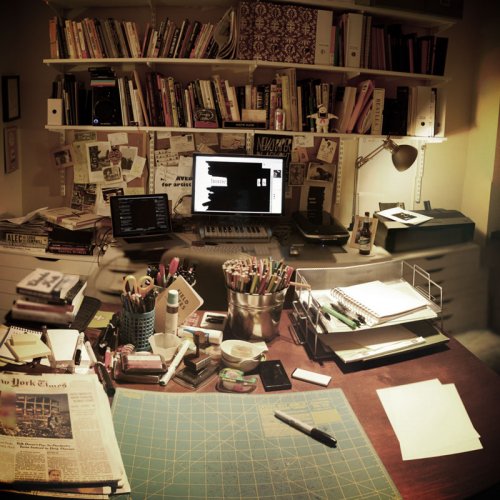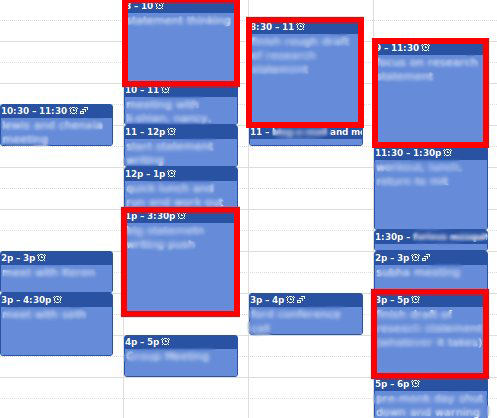
This post originally appeared on the Crew blog.
Nothing seems further from creativity than routine (to me, anyway). Routine conjures up 9-5 workdays, long commutes and words like boring, stuffy and repetitive. None of the things I associate with being creative.
But the funny thing is, routine is really common for great artists. Rather than sitting around waiting for inspiration to show up, successful creative people use routines to wrangle their creative skills.
They get up at the same time, maybe eat the same breakfast every day, and most importantly sit at their desk or stand in their studio at the same time every day.
Franz Kafka started writing at 11 pm each night. Benjamin Franklin woke up at 5 am each day to ask himself “What good shall I do this day?” Stephen King always has a glass of water or a cup of tea beside him as he writes. He says routine helps him get ready to create:
The cumulative purpose of doing these things the same way every day seems to be a way of saying to the mind, you’re going to be dreaming soon.
Planning
As part of my own avoidance of routine in recent years, lest I become boring, stuffy and repetitive myself, I’ve also enjoyed keeping my planning activities to a minimum.
Unfortunately, I confused ‘never planning anything’ with ‘being able to go with the flow.’ They’re not the same, and they’re not even mutually exclusive—you can plan ahead and still go with the flow when surprises pop up.
Planning ahead will actually prepare you for what’s coming up so you can more easily work in last minute changes to your schedule. If an event pops up that you want to go to, or a great opportunity to expose your work to new people, knowing what deadlines are looming and how much work you have ahead of you makes it easier to make a snap decision.
Just as importantly, when you plan out your work schedule and any deadlines you need to hit, you can be more realistic in estimating how much time you have for a project. Although it’s no guarantee, planning can help you avoid those all-too-common scenarios of cramming to finish a project just before the deadline due to procrastination or underestimating how much time you needed.
Planning doesn’t have to include a rigid, hour-by-hour schedule, though. This example from Amber Rae shows how you can plan ahead without being too rigid:
Giving your creative brain space
One of my favorite talks about creativity, which I tend to reference a lot, is this one by John Cleese about the tortoise brain. Cleese explains how his own experience with comedy writing taught him how much of our creative thinking comes from our subconscious—what he calls the tortoise brain.
The tortoise brain is pretty nervous, and has to be coaxed out of its shell. The best way of doing this, according to Cleese, is to create an environment that’s safe for the tortoise. In terms of creative thinking, that means giving yourself time and space. A separate space where your creative work happens, and time to relax and let your tortoise brain do the work.
Writer Austin Kleon has two separate desks in his workroom: one for creative work that’s covered with paper, pencils, and other analogue tools, and one for research and other serious work that holds his computer.
This lets his tortoise know when it’s safe to come out: if he’s sitting at the analogue desk, that’s creative thinking time.
Time is just as important as space. As Cal Newport explains, creative work requires long stretches of uninterrupted time:
Real creative work is non-linear, often requiring long, unexpected detours to uncover the contours of the problem at hand. Long stretches of time provide the freedom needed to feel comfortable indulging in these detours.
Showing up
I write only when inspiration strikes. Fortunately it strikes every morning at nine o’clock sharp. — Somerset Maugham
From my own experience, I’ve found stuffing my creative work into the confines of a routine is most valuable in terms of just showing up. Like the quote above alludes to, an artist has to show up every day if they expect inspiration to also show up.
Every creative person I know agrees that showing up is often the hardest part of their work. How many times have you avoided working on something for ages only to find when you finally force yourself to sit down and start it’s not too bad after all? It’s that sitting down and starting—writing the first word, drawing the first line, making the first move towards creating something new—that hurts the most. It’s the showing up.
A routine takes away the choice of showing up. If there’s no question about whether you’re getting out of bed at 6am or not, because it’s what you do every single day, then you can do it. Just do it without thinking because it’s your routine. It’s not a choice.
When 8 am rolls around, you sit at your desk to write or walk into your studio to paint or draw, or enter whatever space you’ve created for your work. If 8 am is the time you start working, and it’s part of your routine, you just do it.
Don’t think about it, don’t worry about inspiration or motivation—they’ll come. Just start working and see what happens.
I don’t want to leave you on such a fluffy, philosophical note. Let’s close with some actionable steps to develop a routine and start wrangling that crazy, creative spirit you’ve got.
Schedule your work time
Decide when you’ll show up and put it on your calendar. Cal Newport adds big blocks of time to his calendar for creative work:
When you write it down, decide to stick to it, no matter what, for a week. Every day, at that time, start working. Don’t even worry about how long you work for to start with, just get yourself into the habit of starting work at the same time every day. When you’ve found a time that works for you, stick to it for two weeks, and then a month.
There’s no set time that it’ll take you to develop a routine that happens without you thinking about it, but you’ll feel it happening. When you’re walking to your creative workspace at the set time without realizing it, that’s a true habit starting to form.
Create a safe space for your tortoise
Although it takes our tortoise brain a while to warm up and trust in the safety of the environment before it will pop its head out, Cleese maintains that a regular space for creating new work and a set time will help us encourage the tortoise to pop its head out faster each time, as it recognizes the creative space we’re in.
If you haven’t already, set aside a physical space to get your creative work done. And adjust the surroundings to suit your work: add inspiration to the walls, set up speakers for the music or podcasts you like to listen to while you work, and make sure you have the tools you need available.
In Austin Kleon’s case, he keeps his creative desk covered in analogue tools like pencils and paper that encourage exploring with his hands. For him, that’s what helps encourage his tortoise brain to pop out and help him create.
Just start
For a long time I struggled to understand the practical application of advice to start working without waiting for inspiration.
What do you draw if you haven’t thought of anything to draw yet?
What do you write before you have any ideas?
In my case, I usually start with a stream of consciousness, or a riff on whatever I’m thinking about at the time. If something in particular is playing on my mind, I’ll write about that situation. I’ll write to explore the concept in detail and in abstract, to look at it from different angles, and to imagine how other people might approach it.
Sometimes a real idea will come out of this free-form exploration. Other times I trash the whole thing, but it acts as a warm-up for my creative juices either way.
I also keep a list of topic ideas that I’d like to write about some day, and I often grab one of these to give me something to get started with. Keeping a running list or scrapbook of notes, ideas or concepts you’re interested in can give you a starting point for those times when you show up before inspiration does.
Though it seems counterintuitive, my own experience and many, many stories of great artists show that a routine really does help us wrangle our creativity.
Read next: What to Do When You Have Too Many Ideas, Not Enough Time
Get the TNW newsletter
Get the most important tech news in your inbox each week.




